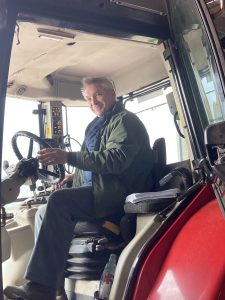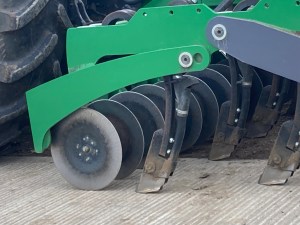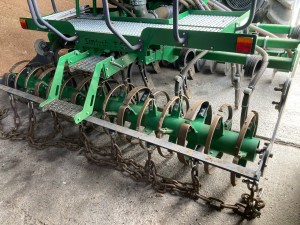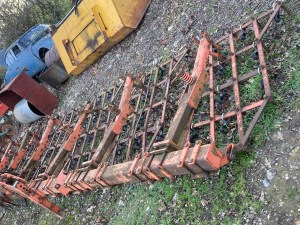Seeking to bring drilling back in-house on a relatively small acreage following on- and off-farm business changes, one Norfolk farmer moved to no-till crop establishment and an uncomplicated tine-based seeder to achieve his aim. CPM paid him a visit.
“I was especially interested in the merits of moving less soil, particularly as we have a mix of light Breckland loam and heavier clays.”
By Martin Rickatson
Plenty of farmers have a diversification or outside business interest beyond their arable enterprise, however, Norfolk farmer Andrew Soar’s isn’t a livery yard, wedding barn or set of storage units. From the workshops in his yard at Bressingham, near Diss, he makes replica Aston Martin sports cars for historic motor racing enthusiasts.
It’s a business he has built up over the past 15 years, with customers around the world growing in number year on year – until the arrival of uncertainty over the UK’s departure from the EU in 2019 and coronavirus the following year.
“We’re now on track again as the world has slowly got back to normal, building three cars a year. But when everything was up in the air three years ago, car-building ceased and I began to reassess the way I was running my arable enterprise,” explains Andrew.

Andrew Soar says he isn’t afraid to make additional passes for pre-drilling loosening and post-drilling rolling, where necessary.
“As the car business had grown, I’d contracted out a lot of field operations, including crop establishment and spraying, although I kept fertilising and harvesting in-house. While I have a team working with me on the cars, there’s just me on the farm. At 85ha, it isn’t big by current standards but that’s what makes regular reassessment of the value of contract versus in-house machinery activities worthwhile.
“In 2019, when things looked uncertain around the Brexit deal likely to be done, and into the following year when COVID-19 hit, the car business went a bit quiet as people waited to see what would happen. So I took the opportunity to look more closely at the things it still made sense for our contractor to do, and the things I could still do myself.
Andrew had scaled back his farm work outside of harvest and he describes his equipment, such as the Accord DA power harrow combination drill, as ‘on its last legs’. Consequently, it made sense to contract out cultivations and drilling for combinable crops, in addition to the sugar beet drilling and harvesting that his contractor has always done.
“Sugar beet has been a challenging crop in recent years. We did try oilseed rape, briefly, but didn’t really get on with it. The car business was getting busier, so for a time we returned to the beet and had all operations done by the contractor to minimise costs,” he explains.
“But beet land does take a battering, which doesn’t suit following no-tilled crops. I may yet look at linseed or peas as alternatives but, on this acreage, I need to be able to grow good quantities of decent combinable crops as I don’t have lots of different storage.
For financial and practical reasons, Andrew explains he’d become keener on carrying out more of the combinable crop work himself, bar the spraying. “I was especially interested in the merits of moving less soil, particularly as we have a mix of light Breckland loam and heavier clays. The idea of one-pass drilling was also appealing as it meant I could potentially do all my own combinable crop work establishment. With grant funding also becoming available for reduced-tillage drills, the sums around investing in my own drill started to stack up.”
To marry with the size of his farm, Andrew was looking for a 3m machine that was relatively simple compared with some of the more complex and expensive alternatives. “I considered a Moore Uni-drill, but settled on the idea of a tine drill, as I think disc coulters are more likely to clog and smear on these soils if conditions are a bit damp, plus they require more maintenance,” he says.

The Simtech T-Sem’s tine coulters are staggered over three rows, which has been found to do a good job aiding trash flow.
“Simtech came to my attention as the company was based nearby and the drill design appealed because of its simplicity, the fact it isn’t as heavy as some alternatives, and the versatility it offers – being able to work in a variety of situations and conditions.
“There are drills that use a similar T-slot principle, but these tend to be heavier and require more power, not only being expensive in themselves but also requiring a bigger tractor.”
Ultimately Andrew ordered the 3.0m T-Sem 300AP arable airseeder and when it arrived, he decided to give it a challenge with some post-sugar beet land, which had turned very wet post-lifting and had retained water, even after ploughing.
“My rotation is askew at the moment because of recent wet winters, but these also reinforced the fact that not only does my time get squeezed by my other business’s demands, ploughing and power harrow drilling are very time consuming and put me more at the mercy of the weather if it turns bad. My fields are also fairly small, and with multiple passes and machines that also means a lot of time spent moving kit on my own,” he says.
“So with this post-beet land, I thought there was no point trying to wrestle a barley crop in so I planted a summer cover crop mix, with deep-rooting species to condition the ground. That grew well and, after spraying off in August, this was the first field I drilled with the Simtech.
He explains that there was a lot of vegetation for the drill to tackle. “I considered mowing with a big batwing topper, but then decided to attempt the job in one pass with a flail on the front linkage to mulch the dead vegetation ahead of the drill on the back.

Each seeding row on the Simtech T-Sem begins with a straight disc that slices an opening for the following inverted T-shaped seeding boot.
“That worked well, knocking the material down sufficiently for the drill to slice through the residue without blockage issues. The only challenge was that without markers, and with no guidance/auto-steering on my tractor, it was difficult to follow an edge to see accurately where I’d been, and that showed later with some wider gaps than I’d have liked between the drill joins,” says Andrew.
“I’d also changed my tractor, exchanging a Massey Ferguson 6470 and a 6480 for one 150hp MF 6715S, and with a different bonnet out front, a different width and view and slightly different tyre positions, I found it more challenging to keep my reference points for positioning. Guidance or auto-steering would be nice but on my size of operation, I can’t justify the investment.”
The Simtech has subsequently been used to establish winter wheat and spring barley, as well as the cover crop mixes used on land intended for spring cereals or beet. With the farm’s contractor having previously used a Sumo Trio ahead of drilling, soils were found to be in good structural condition ahead of the move to the new drill and crop establishment system, and consequently the switchover was made in a single season.

The press rings and following chains are reckoned to be simple and effective, filling the slots with soil without compressing them closed.
“That said, I’ve increased my focus on minimising compaction and ensuring good drainage, on top of keeping traffic to a minimum where possible,” says Andrew.
“That meant investing in a low-draft, low-disturbance 3m Agriweld Min-Disc, with six legs and a heavy packer, to target identified compacted and waterlogged areas, especially headlands. While the post-barley land was fine, the ground was so hard last autumn I had to remove three legs to make progress in wheat stubbles, which I couldn’t really touch until the first rain, but it’s done a good job so far.”
While it works directly on the stubble/soil surface, evenness is important for depth accuracy with the Simtech drill’s rigid 3m frame, so soil presentation/state is still critical, notes Andrew.
“Because there’s minimal soil movement behind the tractor, it’s critical to avoid making deep wheelings, and wide tyres are essential. The 6715S runs on 520/85 R38 rears and 420/85 R28 fronts, and these leave relatively little impression, even on ploughed ground. Last year we drilled onto post-beet ploughed land, adding a press up front, and this combination worked well.”
Andrew has largely maintained his conventional establishment seed rates but does adjust them according to field conditions.
“Initial calibration is simple enough – just a matter of a button-press and weighing the quantity dispensed, doing it three times to make sure. If the third is close to the first, then you know it’s right,” he says.
“On-the-go seed rate adjustment is possible with the 300AP, so I can increase rates in heavier areas where establishment may be more of a challenge and where slugs are a problem. I don’t like using slug pellets, but while I used to sell straw to my contractor, I now chop it all for its potash and organic matter value. To ensure it’s spread evenly to help control slugs, I rake everything with a workshop-built 8m stubble rake.”
While he doesn’t work with a mapping system, Andrew aims to keep to the same tramlines and says they are generally still easy to see even after drilling at an angle to them.

Andrew built his own straw harrow from a second-hand frame and new tines to lightly scratch the surface and distribute chopped material.
“The trade-off for the low costs of direct-drilled crops is the worry waiting for them to emerge, but while they don’t look very pretty through the winter, they rally in the spring and soon grow away from the trash,” he says.
“I’ve had the occasional issue with discs being stuck by trapped stones, and the sticky residue of chopped cover crops can also bung the press rings, but beyond that the drill has worked well. The press rings and following chains are simple and effective – they don’t push the slots closed but are designed to leave them open but filled with soil.
“Whether a following roll pass is needed depends on the conditions. I only roll autumn drilled crops if they require it, but generally roll all spring crops. I had a small issue with one field of spring barley, where the loose soil in the slots lost moisture during dry days after drilling, but the crop soon progressed once we’d had some rain. That taught me the importance of rolling where possible.”
If any autumn was to challenge a direct drill’s ability to penetrate the ground it would be the past one, but Andrew says by the time he commenced drilling cereals in late October, after some rain, there were no problems on this score.
“It’s designed with a weight bias on the front, and this helps slot cutting by the discs, which can also be moved closer to the tractor to aid penetration. And where necessary, I can set the discs to run slightly lower than the coulters to help channel away water from later rainfall on heavier ground, he says.
“I’ll admit some might see this as a large hobby farm, especially as my car business also provides an income, but having it all owned and paid for gives me a bit of flexibility to try new ideas like this without having to worry about paying off the bank.
“I could contract everything out – but then what would I do? The labour alone needed for conventional tillage doesn’t stack up now, and moving to direct drilling with the Simtech has meant I’ve cut drilling time in half and virtually eliminated any pre-drilling work, freeing more time for the car business while still meaning I can control more of the farm work myself.
“It’s a simple drill with low running costs, courtesy of few wearing parts and reduced fuel use, and creates a system that should benefit my soil structure and my herbicide bills.”
This article was taken from the latest issue of CPM. Read the article in full here.
For more articles like this, subscribe here.
Sign up for Crop Production Magazine’s FREE e-newsletter here.




